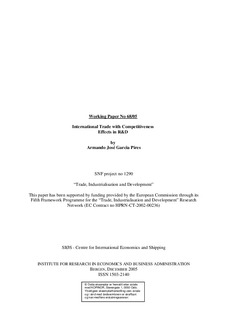| dc.contributor.author | Pires, Armando José Garcia | |
| dc.date.accessioned | 2006-06-21T09:33:00Z | |
| dc.date.available | 2006-06-21T09:33:00Z | |
| dc.date.issued | 2005-12 | |
| dc.identifier.issn | 1503-2140 | |
| dc.identifier.uri | http://hdl.handle.net/11250/166430 | |
| dc.description.abstract | In an oligopoly trade model where firms engage in R&D, international differences in market size allow for the emergence of endogenous asymmetries between firms. Concretely, firms located in countries with more demand become more competitive because they have strong incentives to perform R&D (“home market” and “competitiveness effects” in R&D). As a consequence, these firms have better access to export markets and the countries where they are hosted often also tend to run trade surplus in the oligopolist sector. This shows that cross-border differences at the level of R&D intensity can be a bias for international specialization. | en |
| dc.format.extent | 228130 bytes | |
| dc.format.mimetype | application/pdf | |
| dc.language.iso | eng | en |
| dc.publisher | SNF | en |
| dc.relation.ispartofseries | Working Paper | en |
| dc.relation.ispartofseries | 2005:68 | en |
| dc.subject | international trade | en |
| dc.subject | oligopoly | en |
| dc.subject | R&D investment | en |
| dc.subject | spatial demand markets | en |
| dc.subject | competitiveness effects | en |
| dc.subject | asymmetric firms | en |
| dc.title | International trade with competitiveness effects in R&D | en |
| dc.type | Working paper | en |
